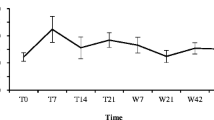Abstract
The purpose of the present investigation was to study the uptake of cadmium in mammary tissue, effects on milk secretion and composition, and lactational transport of cadmium to the sucklings. Cadmium exposure during lactation resulted in retention of cadmium in the mammary tissue in mice and rats. The uptake of cadmium in the mammary tissue was rapid, as shown in lactating mice by whole-body autoradiography 4 h after an intravenous injection of a tracer dose of 109CdCl2. Retention of cadmium in kidneys of suckling pups was observed in the autoradiograms at 7 days after exposure of the dams. Lactating rats were intravenously infused with 109CdCl2 in 0.9% saline via osmotic minipumps from day 3 to day 16 after parturition. The cadmium dose given was 0, 8.8, 62 and 300 μg Cd/kg body wt. per day. Plasma and milk were collected at day 10 and 16 after parturition. Plasma cadmium levels in dams increased from day 10 to day 16. Cadmium levels were higher in milk than in plasma, with milk/plasma ratios varying from 2 to 6. Zinc levels in milk were positively correlated to cadmium levels in milk (r 2=0.26; P=0.03). In milk, 109Cd was distributed in fat (46–52%), casein fraction (40–46%), and whey fraction (6–8%). There was a high correlation between cadmium concentrations in pups' kidney and cadmium concentrations in dam's milk (r 2=0.98; P < 0.001). Of the cadmium dose given to the dams <0.05% was retained in the litters on day 16 of lactation. No effects were observed due to cadmium exposure on body weight in pups or dams. Cadmium treatment did not cause any effect on the lactose or protein concentration in milk, the concentrations of DNA, RNA or the ratio RNA/DNA in the mammary gland. Histological evaluation of mammary tissue did not reveal any abnormalities at any dose level. 109Cd was bound to metallothionein in mammary tissue. The fraction of radiolabelled cadmium bound to metallothionein increased in a dose-dependent manner in both the liver (88–98%) and mammary tissue (57–80%). The present results indicate a low transfer of cadmium to the suckling pup, which might be due to binding of cadmium to metallothionein in the mammary tissue. However, during the susceptible developmental period even a low cadmium exposure may be of concern.
Similar content being viewed by others
Author information
Authors and Affiliations
Additional information
Received: 26 July 1999 / Accepted: 21 September 1999
Rights and permissions
About this article
Cite this article
Petersson Grawé, K., Oskarsson, A. Cadmium in milk and mammary gland in rats and mice. Arch Toxicol 73, 519–527 (2000). https://doi.org/10.1007/s002040050003
Issue Date:
DOI: https://doi.org/10.1007/s002040050003




